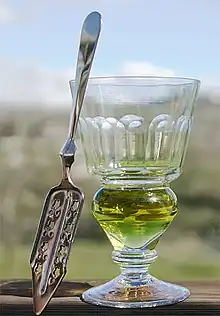 | |
| Names | |
|---|---|
| IUPAC name
1,3,3-Trimethylbicyclo[2.2.1]heptan-2-one | |
| Other names
1,3,3-Trimethyl-2-norcamphanone | |
| Identifiers | |
3D model (JSmol) |
|
| ChEBI | |
| ChemSpider | |
| ECHA InfoCard | 100.013.458 |
| KEGG | |
PubChem CID |
|
| UNII | |
CompTox Dashboard (EPA) |
|
| |
| |
| Properties | |
| C10H16O | |
| Molar mass | 152.23 g/mol |
| Density | 0.948 g/cm3 |
| Melting point | 6.1 °C (43.0 °F; 279.2 K) |
| Boiling point | 193.5 °C (380.3 °F; 466.6 K) |
Refractive index (nD) |
1.4625 |
Except where otherwise noted, data are given for materials in their standard state (at 25 °C [77 °F], 100 kPa).
Infobox references | |
Fenchone is an organic compound classified as a monoterpenoid and a ketone. It is a colorless oily liquid. It has a structure and an odor similar to those of camphor. Fenchone is a constituent of absinthe and the essential oil of fennel. Fenchone is used as a flavor in foods and in perfumery.[2]
Other names for fenchone include dl-fenchone and (±)-fenchone. It is a mixture of the enantiomers d-fenchone and l-fenchone. Other names for d-fenchone include (+)-fenchone and (1S,4R)-fenchone. Other names for l-fenchone include (−)-fenchone and (1R,4S)-fenchone. The d-fenchone enantiomer occurs in pure form in wild, bitter and sweet fennel plants and seeds, whereas the l-fenchone enantiomer occurs in pure form in wormwood, tansy, and cedarleaf.[3]
References
- ↑ Merck Index, 11th Edition, 3911.
- ↑ Karl-Georg Fahlbusch, Franz-Josef Hammerschmidt, Johannes Panten, Wilhelm Pickenhagen, Dietmar Schatkowski, Kurt Bauer, Dorothea Garbe, Horst Surburg "Flavors and Fragrances" in Ullmann's Encyclopedia of Industrial Chemistry, Wiley-VCH, Weinheim: 2002. Published online: 15 January 2003; doi:10.1002/14356007.a11_141.
- ↑ U. Ravid, E. Putievsky, I. Katzir, R. Ikan “Chiral gc analysis of enantiomerically pure fenchone in essential oils” in Flavour and Fragrance Journal, 7: 169-172, John Wiley & Sons: 1992. Published online: June 1992; doi:10.1002/ffj.2730070314.
